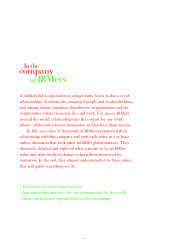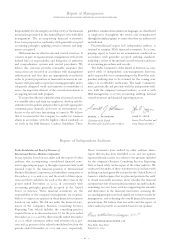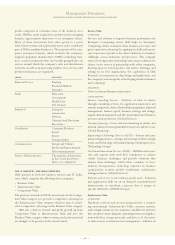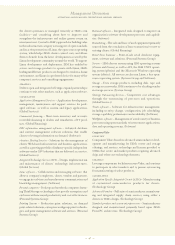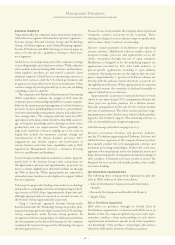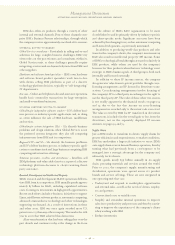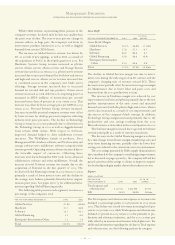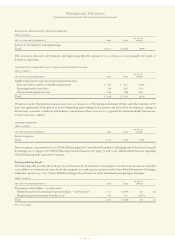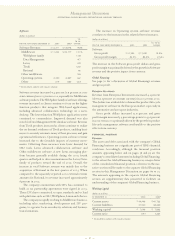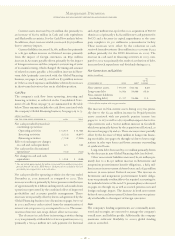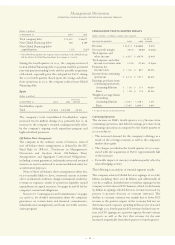IBM 2003 Annual Report Download - page 51
Download and view the complete annual report
Please find page 51 of the 2003 IBM annual report below. You can navigate through the pages in the report by either clicking on the pages listed below, or by using the keyword search tool below to find specific information within the annual report.
IBM also offers its products through a variety of other
internal and external channels. Four of these channels com-
prise IBM’s Business Partner relationships, through which
the company receives approximately one-third of its revenue.
internal routes-to-market
Global Services consultants – Particularly in selling end-to-end
solutions for large, complex business challenges, IBM very
often relies on the practitioners and consultants within its
Global Services unit, as these challenges generally require
integrating services and on demand solutions from IBM and
other suppliers.
Hardware and software brand specialists – IBM’s own hardware
and software brand product specialists work face-to-face
with clients, selling IBM platforms as part of a discrete
technology platform decision, typically to “self-integrating”
IT departments.
ibm.com – Online and telephone sales and assistance operations
handle basic commodity transactions for large enterprises
and small-to-medium businesses.
business partners routes-to-market
Global/major independent software vendors – ISVs deliver busi-
ness process or industry-specific applications and, in doing
so, often influence the sale of IBM hardware, middleware
and services.
Global/major systems integrators (SIs) – SIs identify business
problems and design solutions when Global Services is not
the preferred systems integrator; they also sell computing
infrastructures from IBM and its competitors.
Regional ISVs and SIs – SIs identify the business problems,
and ISVs deliver business process or industry-specific appli-
cations to medium-sized and large businesses requiring IBM
computing infrastructure offerings.
Solutions providers, resellers and distributors – Resellers sell
IBM platforms and value-added services as part of a discrete
technology platform decision to clients wanting third-
party assistance.
Research, Development and Intellectual Property
IBM’s research and development (R&D) operations differen-
tiate IBM from its competitors. IBM annually spends approx-
imately $5 billion for R&D, including capitalized software
costs, focusing its investments in high-growth opportunities.
Recent such efforts include e-business, initiatives to support
Linux, middleware software products, autonomic computing,
advanced semiconductor technology and other technologies
supporting on demand. As a result of innovations in these
and other areas, IBM was once again awarded more U.S.
patents in 2003 than any other company. This marks the 11th
year in a row that IBM achieved this distinction.
Akey transformation that has been taking place over the
past decade and continues today is the change in the focus
and the culture of IBM’s R&D organization to be more
closely linked to and be primarily driven by industry-specific
and client-specific needs. Significant successes have been
achieved by this changing focus, such as autonomic computing
and Linux developments, as previously mentioned.
In addition to producing world-class products and solu-
tions for the company’s clients, the company’s investments in
R&D also result in intellectual property (IP) income. Some
of IBM’s technological breakthroughs are used exclusively in
IBM products, while others are used by the company’s
licensees for their products when that new technology is not
strategic to IBM’s business goals. A third group is both used
internally and licensed externally.
In addition to these IP income sources, the company
also generates value from its patent portfolio through cross-
licensing arrangements and IP licensed in divestiture trans-
actions. Cross-licensing arrangements involve licensing of
the company’s IP to a third party in exchange for the right to
use the third party’s IP. The value of these other two sources
is not readily apparent in the financial results on pages 54
and 74 due to the fact that income on cross-licensing
arrangements is recorded only to the extent cash is received.
The value received by IBM for IP transferred in divestiture
transactions is included in the overall gain or loss from the
divestiture, not in the separately displayed IP income
amounts on pages 54 and 74.
Supply Chain
Just as IBM works to transform its clients’ supply chains for
greater efficiencies and responsiveness to market conditions,
IBM has undertaken a large-scale initiative to recast IBM’s
own supply chain as an on demand business operation, thereby
turning what had previously been a cost/expense to be
managed, into a strategic advantage for the company and,
ultimately, for its clients.
IBM spends nearly $39 billion annually in its supply
chain, procuring materials and services around the world.
Prior to 2002, the company’s supply, manufacturing and
distribution operations were spread across its product
brands and service offerings. These are now integrated in
one operating unit that can:
•Understand and respond to marketplace opportunities
and external risks, as well as the needs of clients, employ-
ees and partners
•Convert fixed costs to variable costs
•Simplify and streamline internal operations to improve
sales force productivity and processes and thereby, contin-
uing to improve the experiences of the company’s clients
when working with IBM
•Reduce inventories
Management Discussion
INTERNATIONAL BUSINESS MACHINES CORPORATION AND SUBSIDIARY COMPANIES
49



